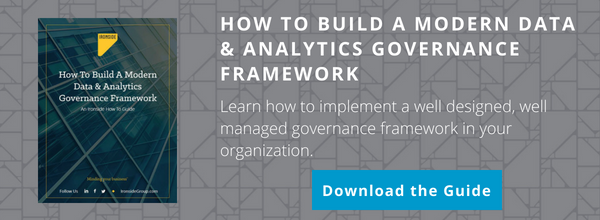Implementing a Successful Master Data Management Solution
Any discussion of Master Data Management automatically includes a discussion of Data Governance. The two go hand in hand. Successful MDM implementations require understanding data ownership, stewardship, and security, as well as determining business rules to be applied to the data. Specific business rules usually include rules for matching and consolidating data items as well as data quality checks.
In an enterprise MDM solution, there are often different owners for each source of data, rules that need to be applied for cleaning and enhancing the data, people responsible for correcting the data, and rules to define the “Golden Record.” Along with all of that comes the need for managing change and communication.
All of these items need to be decided during implementation – but also need to be monitored, maintained, and adjusted once the solution is in operation. This ongoing process to manage data and the policies surrounding that data is data governance. Therefore, a successful Master Data Management implementation requires a defined and successful governance strategy.
Data Ownership
An important part of MDM and Data Governance is correctly defining the ownership of the data. At times this can be a very difficult task. Many organizations think Information Technology (IT) should be in charge of the data because IT owns the system where the data is housed. However, IT is rarely the actual owner of the data. When establishing the owner it is important to understand who can answer questions about the data, provide definitions to the attributes, and determine the validity of the data. Those people are usually the true owners of the data. These people need to be involved in defining business rules for data cleansing, correcting the data and matching and consolidation.
Data Stewardship
Data Stewardship is giving a person or team of people the ability to correct data from within a Master Data Management process. This is usually done programmatically by routing errors within the process to a repository where the data will reside until it is corrected or deleted. Various aspects of this process fall under the realm of data governance, from setting up the rules that define an error that a data steward should review, to setting up the team of stewards and defining the rules in which the steward should correct the data. There are various stewardship models – no one model is right for every enterprise.
When defining the rules for what error will trigger the record to be sent to the steward repository, it’s important to limit the amount of data that is sent to the stewards. If a rule will trigger large data volumes to fail, that should be corrected with a rule during data cleansing. There should also be enough data on the record to help the steward in determining how to correct the record. If there is no way for the steward to correct the data, then that data should be potentially eliminated from the process altogether. Setting up these rules may require a group of individuals from different departments because changes to the rules in the future could impact different departments differently. Establishing a good data governance program will help to manage this process. As data issues and data quality are likely to change over time, it’s important to revisit these rules on a regular basis.
 Defining the team of data stewards can also be a challenge. Data stewards should be very familiar with the data. Where there is a group of people that could make a correction to the data, you may want only one person to be able to delete a record that could not be corrected. For global organizations, data stewards will often be defined in each region that serves as a source or target of a set of data.
Defining the team of data stewards can also be a challenge. Data stewards should be very familiar with the data. Where there is a group of people that could make a correction to the data, you may want only one person to be able to delete a record that could not be corrected. For global organizations, data stewards will often be defined in each region that serves as a source or target of a set of data.
Lastly, the steward should have the tools they need to correct the data while only correcting the data that caused the failure. For example, data stewards may need to fix addresses, which might require access to maps and address validation tools to aid their review process. However, the same data steward should not be able to update an account number as this would have significant implications on other systems. Since the data steward will be given the responsibility of correcting data that will be used by the organization as a whole, it is critical that governance rules be set to manage this process.
Security
Even though master data is usually considered enterprise-level data, not everyone in an organization is allowed to see all aspects of it. Security can be applied based on various security rules. Managing and communicating these rules is an essential part of a successful MDM solution and is accomplished through governance.
Different departments within the enterprise may be responsible for setting rules for the data they own. They will need to grant permissions to users for the ability to view that data. Specific regions around the world may be responsible for correcting data that is sourced in their region. Security will need to be applied so that they are the only ones responsible for correcting the data from a data steward perspective. These are two examples of how governance and security may be applied to MDM.
Matching and Survivorship Rules
A data entity being mastered will be made up of various attributes. A “Golden Record” representing the most accurate version of that entity might be built from a collection of sources, taking the best data from each and combining them. Rules need to be established to define this process. If an account has three versions in three different sources, which is used – the most current or the most complete? Which data should be chosen to be on the mastered record if all three sources are supplying the same attribute? These are all rules that need to be defined and fall directly within governance. These rules may need to change over time and new sources may be added to the process. All of this will need to be communicated to the organization so data stewards and users of the data understand the process (and can help communicate if it needs to change).
 An example of this applied to an MDM solution could be how to define, match and consolidate an Account. First the Account entity needs to be defined. A sample rule could be: an Account needs to have an Account Name, Address Line 1, Country and either City and State, Province, or Postal Code. Once the definition is complete, match rules need to be defined. Matching on account name and address elements can be done by using various algorithms and setting thresholds. These rules could be initially set conservative (only match if there is a high confidence) and then relaxed over time. Since there are impacts to anyone that sources this data, this also falls within the data governance process.
An example of this applied to an MDM solution could be how to define, match and consolidate an Account. First the Account entity needs to be defined. A sample rule could be: an Account needs to have an Account Name, Address Line 1, Country and either City and State, Province, or Postal Code. Once the definition is complete, match rules need to be defined. Matching on account name and address elements can be done by using various algorithms and setting thresholds. These rules could be initially set conservative (only match if there is a high confidence) and then relaxed over time. Since there are impacts to anyone that sources this data, this also falls within the data governance process.
Along with the Match rules, there need to be Survivorship rules to define which attribute will win when there is a match and the records need to be merged into one. These rules can be set by assigning priority to a source, recency or accuracy rules. Determining and communicating these rules is something the governance team will be responsible for.
Conclusion
Data Governance plays a crucial role in Master Data Management. Without it, successfully implementing a MDM solution will be difficult. The same governance strategy might not work for every company. Whatever strategy a company uses, it should at minimum focus on the following:
Defining Data Elements – Who truly owns the data, mastered entities and attributes? This may be a group of people that need to work together. Different groups may own all the sources that make up an entity, but they will all need to work together to properly define it.
Business Rules – Business rules are extremely important because they will define how data is improved, matched, and consolidated.
Communication – Without effective communication, any program will fail. Since master data is usually used throughout the enterprise, it is even more important to communicate statuses and updates. Anyone that uses the master data should understand how the solution works, how they will be impacted by a change or issue and be kept in the loop if a change or issue occurs.
The governance strategy may change over time as the MDM solution and the enterprise matures. No matter how mature the governance strategy is, focusing on the above items will help ensure an effective MDM solution.
About Ironside
Ironside was founded in 1999 as an enterprise data and analytics solution provider and system integrator. Our clients hire us to acquire, enrich and measure their data so they can make smarter, better decisions about their business. No matter your industry or specific business challenges, Ironside has the experience, perspective and agility to help transform your analytic environment.






